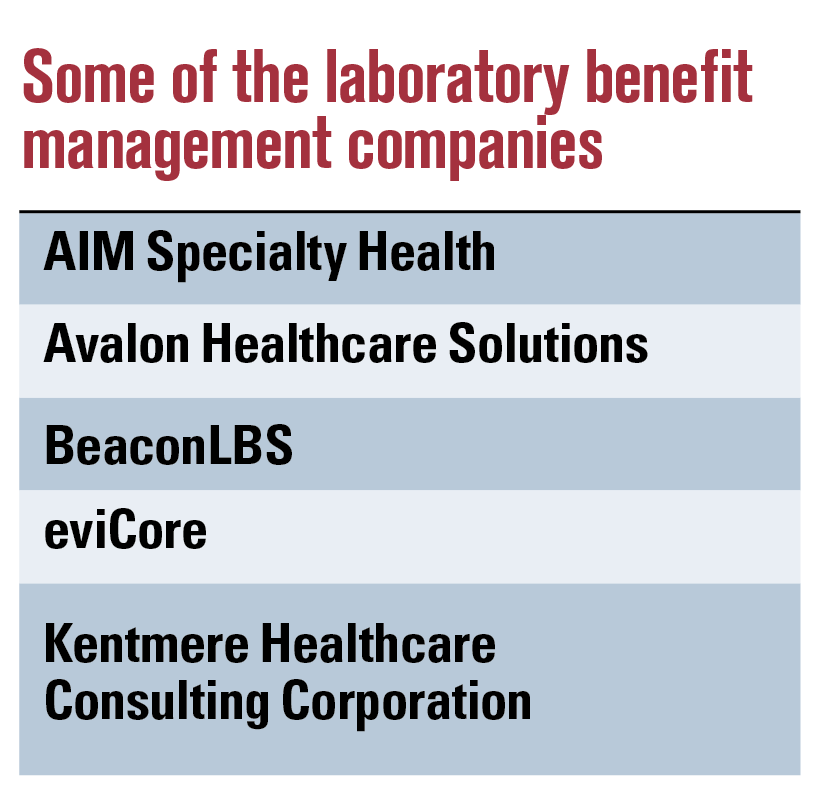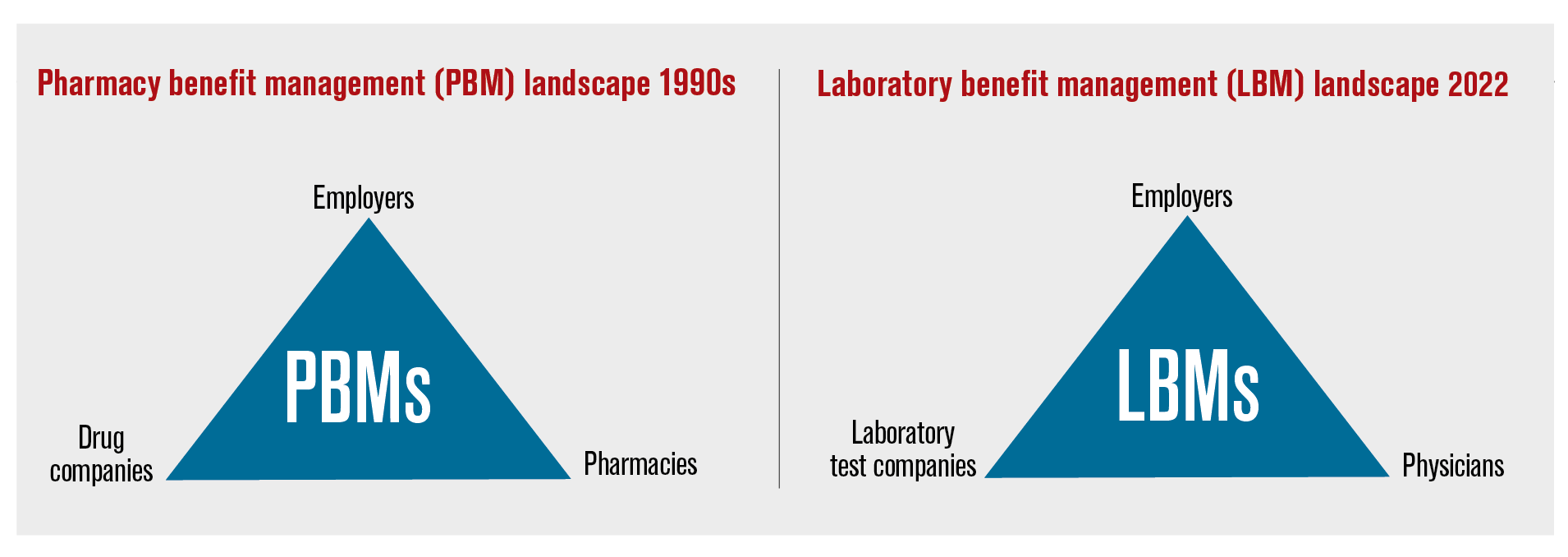The Time is Now for Laboratory Benefit Management
As personalized medicine grows, so does the need for specialized management of laboratory testing.
In the early 1990s, employers started to carve out prescription drug coverage from the medical benefit. This separation evolved into the pharmacy benefit management (PBM) industry of today. PBMs’ landscape focused on managing the cost of the pharmacy benefit and managing drug companies and pharmacies (see chart). PBMs consolidated the purchasing power of employers to obtain rebates from drug companies and discounts for pharmacies.
Over the past several years, a similar development has been occurring with laboratory testing. With the development of thousands of new diagnostic tests, the need for managing the cost of the laboratory benefit is now necessary. Laboratory benefit management (LBM) companies act as an intermediary between laboratory test companies and physicians to manage the use of certain laboratory tests.
What is an LBM?

LBMs fill the need to manage laboratory testing for payers, which include employers who are self-insured and health insurers. LBMs that can offer a range of services are gaining influence over clinical lab testing in important ways. They perform several functions, ranging from educating to obtaining prior authorization to setting formularies and determining coverage policies. They also manage claims and the utilization of lab tests, often reviewing medical necessity.
Some payers adopt LBM coverage policies wholesale, whereas others check their own internally developed policies against LBM policies to see whether their own policies might be improved.
Types of tests
Routine tests make up most of the market, including common lab tests such as complete blood count, lipid and liver panels, urinalysis and cultures for infectious diseases. However, much of the recent growth in the number and expense of laboratory tests relates to specific conditions such as cancer, cardiovascular disease and diabetes. Examples of diagnostic tests include the following:
- Molecular gene tests determine the order of DNA building blocks (nucleotides) in an individual’s genetic code, a process called DNA sequencing. The purpose of these tests is to identify genetic changes that can cause disease. This is commonly referred to as somatic testing.
- Chromosomal tests analyze whole chromosomes to identify large-scale changes, such as an extra (trisomy) or missing (monosomy) copy of a chromosome, or abnormalities of large segments of chromosomes that underlie certain genetic conditions. This is commonly referred to as germline testing.
Tests are reimbursed according to current procedural terminology codes. Currently, there are approximately 1,860 codes. The price of these tests can vary greatly, ranging between $2,000 and $12,000. The high prices and the number of tests clinicians are ordering can make lab tests a cost burden for payers. As a result, they are seeking ways to better manage the use and reimbursement of such tests. However, the soaring number of tests is outpacing formularies, billing code sets and clinical utility evidence, which are all necessary for coverage determinations.
Many professional societies have issued guidelines that spell out which tests are medically necessary, but in reality there is minimal adherence to these stated guidelines. In addition, there is just not much agreement on when these tests should be completed.
Today, there often is confusion about which tests get ordered and why. To some extent, the tests physicians order are determined by the pathology laboratories that do the tests. Some are done in-house by the lab, whereas others are sent to an outside lab. Certain payers have said the most efficient use of resources is to have an agreed-upon panel of tests set for each cancer type. The pathology labs are opposed to this practice because it impedes their ability to differentiate their services and may affect their profitability. Labs competing for market share want to be able to control the integrity of their profiling systems from both financial and performance standpoints. That competition can lead to fragmentation.

Payers are also contributing to the chaos. Many have minimal understanding of the evolving technology of genetic testing. They believe that by limiting molecular testing to more traditional methods, as opposed to next-generation sequencing or cell-free DNA technologies, they are controlling cost. Just the opposite may happen. In response to limiting reimbursement to older standards of practice, some laboratories have been known to resort to billing multiple gene codes, also known as stacked billing. As a result, it is not always apparent to the payer whether the tests were appropriate for the patient.
Stuck in the middle are the physicians. They may be knowledgeable about the current recommendation, but labs and payers have turned ordering lab tests into a tug of war. A lab may recommend a test that may be clinically appropriate for the patient, according to current guidelines, and the payer may say the test is not medically necessary, per their coverage policy. But payers also have reason to be wary of unnecessary lab tests ordered because they increase revenues and profits for the labs.
Do LBMs provide value?
Both Avalon Healthcare Solutions and Kentmere Healthcare Consulting Corporation state their services can cut the cost of clinical lab testing. Avalon has stated payers can cut costs from between 8% to 12%. Kentmere’s website says health plans can get a 20-to-1 return on their investment.
Several industry associations, such as AHIP, American Medical Association, and Blue Cross Blue Shield Association have reported that LBMs improved genetic test payment turnaround times but also that prior authorization denials have increased.
Are tests providing value?
Research generally supports the positive financial impact of genetic testing. The research is largely done on specific diseases. For example, for certain gastrointestinal tumors, studies indicate cost-effectiveness for genetic testing of $92,000 compared with typical treatment regimes. Testing ensures appropriate drug therapy as a part of precision medicine, as well as the avoidance of costly invasive exploratory procedures (e.g., biopsies) that are currently the standard of care.
Summary
Although there are differences between PBMs and LBMs, employers can transfer the lessons from one industry segment to another. For the most part, PBMs have provided value to employers in the form of formulary management, utilization management and lower drug costs through volume purchases and rebates. On the flip side, payers acknowledge that PBMs have their limitations and require oversight.
Employers should consider using an LBM to help manage the coverage, reimbursement, claims payment and utilization management of laboratory tests. As the market develops, employers should understand that LBMs provide only a portion of the requirements for better precision medicine and develop strategies to gain a greater benefit.

Extending the Capabilities of the EHR Through Automation
August 2nd 2023Welcome back to another episode of "Tuning In to the C-Suite," where Briana Contreras, an editor of Managed Healthcare Executive, had the pleasure of chatting with Cindy Gaines, chief clinical transformation officer at Lumeon.
Listen
Premiums for Employer-based Health Insurance Increased by 7% in 2024, Says KFF Report
Published: October 9th 2024 | Updated: October 9th 2024The 2024 increase is the same as last year's increase for family coverage. The foundation’s annual survey of employer health benefits also found that only 18% of large employers (200 employees are more) are covering the GLP-1 weight loss drugs.
Read More
Florida Gets the OK. But Will Drug Importation from Canada Actually Happen?
March 5th 2024Canadian health officials warn that maintaining a drug supply for Canadians is their priority. The staunch opposition of the U.S. pharmaceutical industry may also be an obstacle to imports from north of the border.
Read More